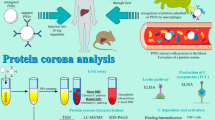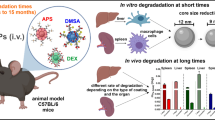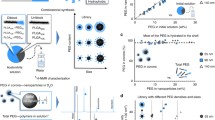Abstract
Purpose. The organ distribution of radiolabeled poly (methyl methacrylate) (PMMA) nanoparticles coated with plasma proteins and serum complement in rats was studied in order to determine the effect of serum complement on the particle phagocytosis by the organs of the reticulo-endothelial system (RES).
Methods. PMMA-nanoparticles were coated overnight with plasma proteins or serum complement, and injected into Wistar rats. The body distribution of nanoparticles was measured by means of scintillation counting of organ samples. In addition, proteins adsorbed to the particle surface were inactivated by heat treatment prior to injection, and the particles's distribution was measured as described above.
Results. Whereas uncoated nanoparticles (control group) were mainly taken up by the Kupffer cells in the liver, incubation of the particles in plasma for 12 h followed by heat inactivation reduced the particle concentrations in the liver to merely 22% after 30 min. After 120 min, liver concentrations were still lower than the control group, and almost 30% of the administered dose of the heat-inactivated particle group was present in non-RES organs and tissues. Particles with non-inactivated complement were accumulated in the lung at concentrations of 29% after 30 min, which increased to 71% after 120 min, whereas those coated with inactivated complement reached lung concentrations above 70% already after 30 min.
Conclusions. Particles coated with plasma components are able to avoid uptake by the RES, especially after heat inactivation of the plasma components adsorbed. Adsorption and heat inactivation of complement proteins alone, however, does not have the same result as coating with plasma proteins followed by heat inactivation. Therefore, it is concluded that plasma components other than complement proteins take part in the process of RES activation and phagocytosis of injected nanoparticles.
Similar content being viewed by others
REFERENCES
J. W. B. Bradfield. The reticulo-endothelial system and blood clearance. In S. S. Davis, L. Illum, J. G. McVie and E. Tomlinson (eds.), Microspheres and Drug Therapy. Pharmaceutical, Immunological and Medical Aspects, Elsevier Science Publishers B. V., Amsterdam, 1984, pp. 25–37.
M. D. Kazatchkine and M. P. Carreno. Activation of the complement system at the interface between blood and artificial surfaces. Biomaterials 9:30–35 (1988).
G. Borchard and J. Kreuter. Interaction of serum components with poly (methyl methacrylate) nanoparticles and the resulting body distribution after intravenous injection in rats. J. Drug Target. 1:15–19 (1993).
S. D. Tröster, U. Müller, and J. Kreuter. Modification of the body distribution of poly(methyl methacrylate) nanoparticles in rats by coating with surfactants. Int. J. Pharm. 61:85–100 (1990).
G. Borchard, S. Brandriss, J. Kreuter, and S. Margel. Body distribution of 75Se-radio-labeled silica nanoparticles covalently coated with ω-functionalized surfactants after intravenous injection in rats. J. Drug Target. 2:61–77 (1994).
J. F. Scieszka, L. L. Maggiora, S. D. Wright, and M. J. Cho. Role of complements C3 and C5 in the phagocytosis of liposomes by human neutrophils. Pharm. Res. 8(1):65–69 (1991).
T. Blunk, D. F. Hochstrasser, B. W. Müller, and R. H. Müller. Differential adsorption: Effect of plasma protein adsorption patterns on organ distribution of colloidal drug carriers. Proceed. Intern. Symp. Control. Rel. Bioact. Mater. 20:256–257 (1993).
D. F. Hochstrasser, M. G. Harrington, A.-C. Hochstrasser, M. J. Miller, and C. R. Merril. Methods for increasing the resolution of two-dimensional protein electrophoresis. Anal. Biochem. 173:424–435 (1988).
T. Blunk, D. F. Hochstrasser, J.-C. Sanchez, B. W. Müller, and R. H. Müller. Colloidal carriers for intravenous drug targeting: Plasma protein adsorption patterns on surface-modified latex particles evaluated by two-dimensional polyacrylamide gel electrophoresis. Electrophoresis 14:1382–1387 (1993).
J.-C. Leroux, P. Gravel, L. Balant, B. Volet, B. M. Anner, E. Allémann, E. Doelker, and R. Gurny. Internalization of poly(D,L-lactic acid) nanoparticles by isolated human leukocytes and analysis of plasma proteins adsorbed onto the particles. J. Biomed. Mater. Res. 28:471–481 (1994).
K. Tessmar. Makromolekulare Stoffe. In: E. Müller (ed.), Methoden der Organischen Chemie, Vol XIV/1, 1961, pp. 1037–1038.
J. F. Scieszka and M. J. Cho. Cellular uptake of a fluid-phase marker by human neutrophils from solutions and liposomes. Pharm. Res. 5:352–358 (1988).
V. Lenaerts, J. F. Nagelkerke, T. J. C. van Berkel, P. Couvreur, L. Grislain, M. Roland, and P. Speiser. In vivo uptake of polyisobutylcyanoacrylate nanoparticles by rat liver, Kupffer, endothelial and parenchymal cells. J. Pharm. Sci. 73:980–982 (1984).
P. G. Waser, U. Müller, J. Kreuter, S. Berger, K. Munz, E. Kaiser, and B. Pfluger. Localization of colloial particles (liposomes, hexylcyanoacrylate nanoparticles and albumin nanoparticles) by histology and audioradiography in mice. Int. J. Pharm. 39:213–227 (1987).
L. Adlersberg, J. M. Singer, and E. Ende. Redistribution and elimination of intravenously injected latex particles in mice. J. Reticuloendothel. Soc. 6:536–560 (1969).
J. Kreuter, U. Täuber, and V. Illi. Distribution and elimination of poly (methyl-2-C14-methacrylate) nanoparticle radioactivity after injection in rats and mice. J. Pharm. Sci. 68:1443–1447 (1979).
A. E. Warner and J. D. Brain. The cell biology and pathogenic role of pulmonary intravascular macrophages. Am. J. Physiol. Lung Cell Mol. Physiol. 258(2):L1–L2; (1990).
Author information
Authors and Affiliations
Rights and permissions
About this article
Cite this article
Borchard, G., Kreuter, J. The Role of Serum Complement on the Organ Distribution of Intravenously Administered Poly (methyl methacrylate) Nanoparticles: Effects of Pre-Coating with Plasma and with Serum Complement. Pharm Res 13, 1055–1058 (1996). https://doi.org/10.1023/A:1016010808522
Issue Date:
DOI: https://doi.org/10.1023/A:1016010808522




